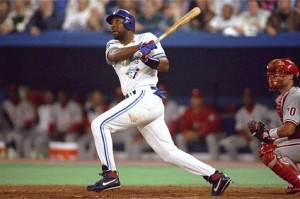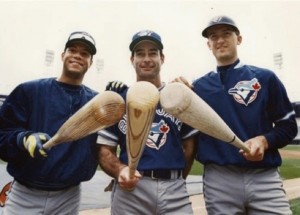A look into the team’s ascension to greatness and its heydays
Part 5: Reaching the pinnacle (Part 1 of Double Truck)

After Toronto became the first ever non-U.S.-based team to win the Fall Classic on 24 October 1992, GM Pat Gillick intended to keep as much of the team together as possible. Since the Blue Jays’ championship window was still open, it would have been foolish to dismantle the core when the team was still very capable of competing for another World Series title in the next season. Some degree of roster turnover was inevitable given that certain players’ contracts were ending. Not only were players who had average seasons with expiring contracts primed to be non-tendered (e.g. Lee) or traded (e.g. Gruber) so that the club could add to its talent level, but even good players who were finishing up the last year of their contracts (e.g. Cone, Key, Henke, Maldonado, and Winfield) were likely to be cut loose. This is because it was not feasible for the Blue Jays to bring them back financially speaking since their salary demands would have been inflated as a result of having played for a World Series Championship team. New pieces (i.e. players who offered similar skill sets and production levels to those who were set to depart) would therefore need to be brought in either internally (in the form of blue-chip prospects who were ready for prime time) or externally (in the form of unrestricted free agency). That said, even though adjustments and fine-tuning were needed, all hands associated with the franchise had a “win now” mentally and wanted to keep the gravy train going on for as long as possible.
By all accounts, Gillick utilized the same strategy from the season before to send the 1993 team, which posted an equally impressive 95-67 regular season record, to its second consecutive World Series title. He began by making two major signings on the free agent market. First, he inked former Oakland Athletics ace Dave Stewart (who had four consecutive twenty-plus win seasons from 1987 to 1990) to a two-year contract worth $8.5 million on 8 December 1992 to offset, at least partially, the loss of Cone (who signed with the Kansas City Royals) and Key (who signed with the New York Yankees). Gillick then shocked the baseball landscape by signing long-time Milwaukee Brewer star Paul Moiltor to a three-year contract worth $13 million on 7 December 1992 to take over the full-time designated hitter’s duties previously occupied by fan favourite Dave Winfield (who eventually signed with the Minnesota Twins). While Stewart was no longer as dominant as his earlier days in Oakland, he was nevertheless a steady contributor as he won twelve games in twenty-six starts during the regular season for Toronto. As for Molitor, he was instrumental in helping the Blue Jays win their second World Series title in as many years, hitting an impressive .341 batting average, along with twenty-two home runs and 111 runs batted in during the regular season.
Gillick shrewdly filled the remaining holes as the season progressed. This was a brilliant game plan because the club was still competitive enough to be viable postseason contenders on the strength of its core players, even though it had weaknesses in certain areas, especially at shortstop (given that Lee signed with the Texas Rangers and his supposed replacement Dick Schofield played rather poorly as he batted .191—under the Mendoza line—in thirty-six games before suffering a broken arm) and at left field (seeing that Maldonado had signed with the Chicago Cubs).
Moreover, sealing these leakages later in the season with rental players would save money for the Blue Jays (as their salary would be prorated) not to mention that the acquisition costs would be lower (usually in the form of prospects and cash) and far more manageable (without having to mortgage the entire farm system). Gillick finally pulled the trigger by first repatriating shortstop Fernández on 11 June 1993 (from the New York Mets for Darrin Jackson) and then shortly afterwards pulled a rabbit out of the hat by acquiring all-time stolen base leader Rickey Henderson on 31 July 1993 (from the Athletics for pitching prospect Steve Karsay and a player to be named later, who turned out to be right field prospect JoséHerrera). These two mid-season moves solidified the holes at shortstop and left field created by the free agency departures of Lee and Maldonado. While Henderson did not perform as well as expected, as he only hit a mere .215 for the rest of the regular reason at the top of the batting order, he still put tremendous pressure on opposing pitchers due to his unmatched speed and base-stealing ability. The fact that Fernández had a stellar showing in the 1993 World Series (a record nine runs batted in for shortstops) after being reacquired was an added bonus.
Part 5: Reaching the pinnacle (Part 2 of Double Truck)

As for the vacancies at closer (created by Henke’s free agency departure to Texas) and third base (created by Gruber’s trade to the California Angels for utility infielder Luis Sojo on 8 December 1992), the strong depth of Toronto’s farm system provided the necessary internal solutions to keep the puzzle intact. Ward, who had served as Henke’s setup man from 1988 to 1992 despite effectively having dominant closer stuff himself throughout these years, naturally took over the closer role and established a club record with forty-five saves in the regular season before racking up another four saves and a win in the playoffs. Promising right handed relief pitcher Mike Timlin (who recorded the final out with Carter in the 1992 World Series) admirably stepped into the setup man role (vacated by Ward’s promotion to the closer role). The emergence of Ed Sprague (who sparked a come-from-behind victory by hitting a game-winning two-run homer off Atlanta Braves Closer Jeff Reardon in the ninth inning of Game 2 of the 1992 World Series to shift the momentum of the series in favour of the Blue Jays) as a regular third baseman not only made up for Gruber’s offensive output (Sprague batted a decent .260 with twelve homers and seventy-three runs batted in over 150 regular season games) but arguably provided the Blue Jays with an upgrade at the position. Also, Sprague’s defense was superior at the corner since Gruber’s skills had regressed significantly due to a bone spur on his spine which ultimately resulted in career-ending surgery.
Another positive note was how quickly a number of the young pitchers developed and played contributing roles in the 1993 season. Starting pitcher Pat Hentgen (who later won the 1996 American League Cy Young Award as a Blue Jay) won 19 games after essentially beginning the season as the team’s fifth starter. Left-handed Pitcher Al Leiter also put up impressive numbers (going 9-6 while logging 105 innings with a 4.11 earn run average in thrity-four games of which twelve were starts) as a spot starter and long reliever out of the bullpen.
Finally, even though Toronto’s second World Series title is frequently associated with Carter’s series clinching three-run homer off Philadelphia Phillies closer Mitch Williams in Game 6, it is noteworthy to mention that several position players also put up all-star caliber numbers (and arguably had career years). In addition to Molitor’s outstanding performance (see above), Alomar (a .326 batting average along with seventeen home runs, ninety-three runs batted in, and fifty-five stolen bases); Carter (a .254 batting average along with thirty-three home runs and 121 runs batted in); and Olerud (a club record .363 batting average along with two-hundred hits, fifty-four doubles, twenty-four home runs and 107 runs batted in) also put up superb numbers. In fact, the Blue Jays were so offensively dominant in the 1993 season that Olerud, Molitor, and Alomar finished first, second, and third in the race for the American League batting title, a feat that had not been accomplished in Major League Baseball for nearly a century!
In sum, while plenty of credit should go to Gillick for signing the top available free agents on the open market during the off-seasons and making the ‘right’ mid-season trades to put his teams over the top, Toronto’s deep farm system was also productive enough to help replenish some of the lost talent. Another point to keep in mind is that the Blue Jays basically assumed the role of today’s free-spending New York Yankees as the owner at the time spent his money generously. In fact, Toronto had the highest payroll in the American League East division in 1992 and the highest payroll in all of Major League Baseball in 1993 when the team spent $51,935,034! By comparison, the Braves (at $47,206,416), Yankees (at $46,588,791), Red Sox (at $46,164,788), and the American League West Champion Chicago White Sox (at $42,115,723) had the second, third, fourth, and fifth highest payrolls respectively in 1993 as they rounded out the top five spenders. Specifically, not only was Labatt Brewing Company willing to dish out big bucks for premium unrestricted free agents like Morris and Winfield before the 1992 season, as well as Molitor and Stewart before the 1993 season, it was also willing to take on additional salaries at the trade deadline by acquiring impact players such as Cone in 1992 and Henderson in 1993. Those deadline moves were critical to boosting the team’s already fearsome roster for a deep playoff run that blossomed into back-to-back World Series titles in the memorable 1992 and 1993 seasons. Oh, what a run!
